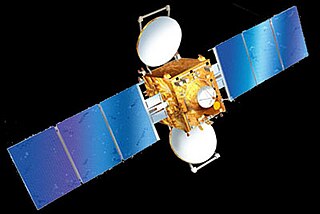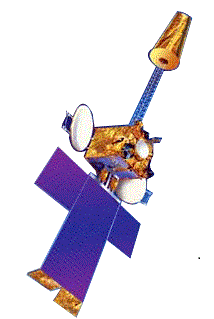Related Research Articles

The Indian National Satellite System or INSAT, is a series of multipurpose geostationary satellites launched by ISRO to satisfy the telecommunications, broadcasting, meteorology, and search and rescue operations. Commissioned in 1983, INSAT is the largest domestic communication system in the Indo-Pacific Region. It is a joint venture of the Department of Space, Department of Telecommunications, India Meteorological Department, All India Radio and Doordarshan. The overall coordination and management of INSAT system rests with the Secretary-level INSAT Coordination Committee.
The Ariane Passenger PayLoad Experiment (APPLE), was an experimental communication satellite with a C-Band transponder launched by the Indian Space Research Organisation on June 19, 1981, by Ariane, a launch vehicle of the European Space Agency (ESA) from Centre Spatial Guyanais near Kourou in French Guiana.

The GSAT satellites are India's indigenously developed communications satellites, used for digital audio, data and video broadcasting. As of 5 December 2018, 20 GSAT satellites of ISRO have been launched out of which 14 satellites are in service.

The Master Control Facility (MCF) is a facility set up by the Indian Space Research Organisation (ISRO) in the city of Hassan in the Indian state of Karnataka. Established in 1982, this facility is responsible for monitoring and controlling geostationary and geosynchronous satellites launched by ISRO. This was the only Master Control Facility of ISRO till another one was established in Bhopal in 2005.
INSAT-3B is an Indian communications satellite which was built by the Indian Space Research Organisation and operated by Indian National Satellite System.
INSAT-2DT, previously Arabsat-1C and also known as INSAT-2R, was a Saudi Arabian and subsequently Indian communications satellite which was operated initially by Arabsat, and then by the Indian National Satellite System.
INSAT-2E is an Indian geostationary communications and weather satellite which is operated by the Indian National Satellite System. It is positioned in geostationary orbit at a longitude of 83° East, from where it is used to provide communications services to Asia and Australia. It also carries two meteorological instruments; the Very High Resolution Radiometer, and a CCD camera capable of returning images with a resolution of one kilometre.

INSAT 3E is a defunct communication satellite built by Indian Space Research Organisation. It was launched on September 28, 2003, from the European Space Agency's spaceport in French Guiana on board the Ariane rocket. The satellite had a launch mass of 2750 kilograms. It is the 4th satellite launched in the INSAT-3 series for INSAT. It was designed for providing high-speed communication, Television, VSAT & Tele-education services and was an important landmark in Indian Space Programme.

INSAT-3A, a multipurpose satellite built by ISRO was launched by Ariane in April 2003. It is located at 93.5 degree East longitude. It is third satellite in INSAT-3 series after INSAT-3B & INSAT-3C. Built at a cost of $53 mn, it provides communication, weather, and search and rescue services.

INSAT-4A was the first one in the INSAT-4 Satellites series, providing services in the Ku and C band frequency bands. At the time of launch, it was the heaviest satellite India had produced. The Ku transponders cover the Indian main land and C-Band transponders cover an extended area. It has a dozen Ku transponders and another dozen of C-band transponders. This spacecraft was placed at 83°E along with INSAT-2E and INSAT-3B, by Ariane launch vehicle (ARIANE5-V169).
GSAT-10 is an Indian communication satellite which was launched by Ariane-5ECA carrier rocket in September 2012. It has 12 KU Band, 12 C Band and 6 lower extended c band transponders, and included a navigation payload to augment GAGAN capacity. Following its launch and on-orbit testing, it was placed in Geosynchronous orbit at 83.0° East, from where it will provide communication services in India.

GSAT-11 is an Indian geostationary communications satellite. The 5854 kg satellite is based on the new I-6K Bus and carry 40 transponders in the Ku-band and Ka-band frequencies, which are capable of providing up to 16 Gbit/s throughput. GSAT-11 is India's heaviest satellite.
INSAT-1C was the third in the first generation INSAT series of satellites built by Ford Aerospace to satisfy the domestic communication requirement of India. The Govt. agencies using its services were All India Radio, Doordarshan, Department of Space and Indian Meteorological Department
INSAT-2B was the second satellite in the INSAT 2 Series that was successfully launched for telecommunication and meteorological observation. This India satellite was launched on 23 July 1993 from Kourou, French Guiana and Ariane-4 being its launch vehicle. INSAT-2B is placed in the geostationary orbit at a longitude of 93.5 degree East. The satellites also carries a search and rescue(SAR) transponder, a data relay transponder and also high resolution radiometer. This radiometer has a resolution of 2 km (1.2 mi) in the normal visible band and of 8 km (5.0 mi) in the thermal infra red band.
GSAT-7 or INSAT-4F is a multi-band military communications satellite developed by the Indian Space Research Organisation. The Indian Navy is the user of the multi-band communication spacecraft, which has been operational since September 2013. According to defense experts, the satellite will enable the navy to extend its blue water capabilities and stop relying on foreign satellites like Inmarsat, which provide communication services to its ships.
INSAT-4B was an Indian communications satellite which forms part of the Indian National Satellite System. Launched in 2007, it was placed in geostationary orbit at a longitude of 93.48° East.

GSAT-18 is an Indian communications satellite. Built by ISRO and operated by INSAT, it carries 24 C-band, 12 extended C-band, and 12 Ku-band transponders.
Intelsat 702 is a geostationary communication satellite that was built by Space Systems/Loral (SSL). It is located in the orbital position of 32.9 degrees east longitude and it is currently in an inclined orbit. The satellite is owned by Intelsat. The satellite was based on the Loral FS-1300 platform and its estimated useful life was 15 years.
INSAT-2D was an Indian communications satellite. Launched on 4 June 1997, and similar to INSAT-2C, INSAT-2D went out of order on October 4, 1997, because of a power inconsistency problem and was later replaced by INSAT-2DT, an in-orbit satellite which was previously known as ARABSAT-1C. The main aim of the satellite was improved communication. In the INSAT-2 series, INSAT-2D was the fourth consecutive communication satellite. The satellite was launched using an Ariane 4 rocket from French Guiana.
The Hispasat 1B was a Spanish communications satellite operated by Hispasat. Along with the Hispasat 1A, the satellite covered communications over the American Continent for both civilian and military customers. Together they formed the first European constellation operating over the New World. Its service life ended in 2003.
References
- ↑ "INSAT-2 (Indian National Satellite-2)". eoPortal. Retrieved 2022-12-09.
- 1 2 "List of Indian Satellites (1975-2022)". Jagran Josh . 2022-02-10. Retrieved 2022-12-09.
- 1 2 "INSAT 2C". NASA Space Science Data Coordinated Archive . Retrieved 2022-12-09.
- 1 2 "India's third indigenous communications satellite, INSAT-2C launched by an Ariane rocket". India Today . Retrieved 2022-12-09.
- ↑ Ahmed, M. (1997-11-26). "Insat-2c Transponder Collapses". Business Standard . Retrieved 2022-12-09.
- ↑ Peterson, Glenn E. (1999). Dynamics of Meteor Outbursts and Satellite Mitigation Strategies. AIAA. ISBN 978-1-56347-197-1.
- ↑ "INSAT-2C". KITE Kerala . Retrieved 2022-12-09.
- ↑ "Satellite: INSAT-2C". World Meteorological Organization . Retrieved 2022-12-09.
- ↑ "INSAT-2C". Indian Space Research Organisation . Retrieved 2022-12-09.
- ↑ "MILESTONES IN SPACE PROGRAMME". Press Information Bureau . Retrieved 2022-12-09.
